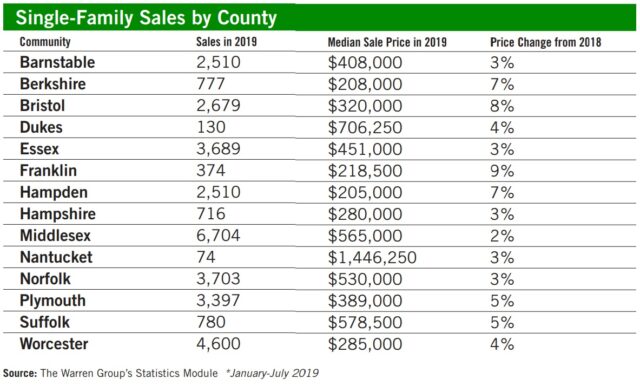Low inventory and record prices for property in Greater Boston fueled major growth in total sales and median sale prices for single-family homes in communities in Worcester, Bristol and Essex counties during the first seven months of 2019.
Worcester County had seven of the top 25 communities with the highest growth in year-over-year sales of single–family homes, and six of the top 25 towns with the fastest-growing median sales prices, the most in either category out of all Massachusetts’ counties, according to The Warren Group, publisher of Banker & Tradesman.
Middlesex County still had the most sales in the same period with 6,704, but with more than 1.6 million residents it has nearly double the population of the next–most populous county – Worcester with 830,839 residents – according to 2018 estimates from the U.S. Census Bureau. Worcester County had the second-largest number of home sales from Jan. 1 through July 31, at 4,600.
Worcester a Draw for Buyers
The local growth spurt was the result of high continually home prices in the Greater Boston area, said Gillian Bonazoli, a Realtor with Coldwell Banker based in Worcester.
“The market in mid-ranged–price homes was very hot this spring,” Bonazoli said. “Inventory remains low and there are many buyers out there. It’s fueled by the Boston market and how people are getting priced out constantly, so there is a ripple effect that’s happening.”
![]()
Spencer and Lunenburg appear on both top 25 lists of the fastest growing markets this year so far; Spencer saw a 26.7 percent growth in home sales year-over-year in the first seven months of 2019, and a 13.4 percent growth in the median sale price. Lunenburg saw a 25.3 percent increase in sales, and 21.6 percent growth in the median sales price.
Bonazoli called the city of Worcester the epicenter of the area, with recent housing and infrastructure developments and cultural growth like the entertainment district growing around the future home of the Boston Red Sox’s Triple-A affiliate, which is moving to Worcester from Pawtucket, Rhode Island in 2021. But she said areas all over the county are growing quickly.

“North and south of the city, those are really up-and-coming areas,” she said. “Even some of the more rural communities are seeing the effects … those are great communities and there are still some wonderful buys out there.”
Georgetown saw the largest growth in the number of sales year over year in the first seven months of 2019, at 67.5 percent, going from 40 sales during that period in 2018 to 67 this year. Essex County had two other communities in the top 10, with Amesbury (29.4 percent) and Hamilton (28 percent) also on the list.
Middlesex County had six communities in the top 25 with the greatest growth in total sales year over year, and three in the top five: Sherborn (42.9 percent), Stoneham (42 percent) and Woburn (40.5 percent).
Swansea saw the largest growth in median sale price through the first seven months, with 26.9 percent, going from $260,000 in 2018 to $330,000 in 2019. Four communities in Bristol County made it into the top 25 with the fastest-growing median sale prices.

First-Time Buyers in a Crunch
The low inventory in Greater Boston is especially affecting buyers looking for their first home, said Anne Meczywor, president of the Massachusetts Association of Realtors.
“What we’re finding is the first–time homebuyers are really getting caught in the crunch,” Meczywor said. “When people start looking away from one area and into another, that’s because they’re weighing out their options. They’re looking at location, but also affordability. Watching what’s happening in Boston is that there is such a shortage of properties on the market … agents are smart to point out other opportunities for them, and then they’re looking at what’s available.”

MAR is one of several organizations supporting Gov. Charlie Baker’s Housing Choice Initiative, which offers communities financial incentives to streamline their zoning approval process and promote new housing developments, especially those that fall under 40R “smart growth” zoning in town centers and near transit. Baker has filed bills on Beacon Hill supporting the initiative in February, including one that would make it much easier for towns to change zoning to support housing developments, but they have not yet come up for a vote in the legislature. Baker hopes to see 135,000 new housing units built in Massachusetts by 2025.
Until the state can add more supply, Meczywor said Realtors have to stay sharp and use their knowledge of local markets to help their buyers find homes they can afford.
“Realtors are feeling the pain for some of their buyers,” she said. “What does come on the market that’s priced well is going very quickly, so everyone has to stay on top of their game and know their inventory.”








